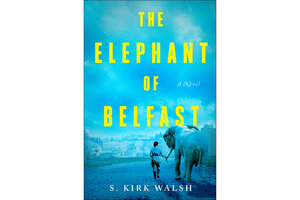‘The Elephant of Belfast’ explores love, loyalty, and tragedy
The World War II novel, based on true events, follows an orphaned elephant and a young zookeeper through struggles that demand courage and sacrifice.

"The Elephant of Belfast" by S. Kirk Walsh, Counterpoint, 336 pp.
Counterpoint
It was the assignment of a lifetime for an aspiring young zookeeper: Helping guide a young elephant from a moored steamship at the Belfast docks to her new home at the zoo.
From that first unusual scene, we’re enveloped in the personalities and the world of “The Elephant of Belfast,” S. Kirk Walsh’s breathtaking novel set in World War II. In the emotional journeys that follow, Walsh explores love, loyalty, and tragedy at a level that makes walking an elephant seem heartbreakingly simple.
Twenty-year-old protagonist Hettie Quin, who is determined and bright, enters the book ready to move forward both professionally and personally in a workplace (and era) dominated by men. She’s reeling from her brilliant sister Anna’s recent death in childbirth, preceded by Anna’s “mixed-faith” Catholic-Protestant elopement and estrangement from their mother. Sorrow, Hettie tells us, has eclipsed international events in her consciousness during those perilous days in 1940. The military occupations of other cities, Luftwaffe bombings in London, all were “like the faint rumblings of a distant train – hardly audible and always receding – and therefore didn’t penetrate the fog of her daily grief.”
With zoo responsibilities to inspire her, Hettie’s competency and independence mature and her capacity for joy gains ground. Romances, friendships, and family ties become more convoluted in the process. Walsh expresses the confusing nature and pitfalls of young adult relationships, and allows both young and old characters the space to reveal themselves, to evolve, and to surprise the reader without ever seeming like they took a false turn.
The supporting cast runs deep: The list includes the elephant herself, Violet, learning to adjust and trust again after her mother was killed by a poacher “in faraway Ceylon,” now Sri Lanka. There’s Hettie’s own distant mother, Rose; Mr. Wright, the chilly head zookeeper who “often spoke with more kindness to the animals than he did to people”; Ferris Poole, the school friend who shares Hettie’s love for nature; and Liam, the brother-in-law who’s maintained a troubling involvement in the IRA. Along with these companions, Hettie even feels the presence of Anna, whispering as the book begins, “She’s your elephant. She’s the one for you.”
That sounds like a lot to keep straight, but the reader never feels lost in this richly drawn world. It’s the opposite: Walsh orients her scenes with such specificity that readers could practically navigate their way around Belfast, taking shortcuts and recognizing familiar landmarks on the Antrim Road.
The reader knows that Hettie’s evolution is a race against time. As she sorts out work and romance (including sometimes troubling sexual encounters), the calendar has inexorably advanced toward the Belfast Blitz, the immensely destructive German air raids of 1941. The dangers that seemed so distant become deeply personal and nearly unbearable.
Responsibility and resilience are twin themes of the book – for both animals and people, as in one terrifying scene in which Hettie rushes to the zoo to comfort Violet as the bombers approach.
“The animals’ calls gained more definition. The growls of lions and leopards. The roars of the black bears. The cackles of the hyenas. ... It was as if a call and response were taking place between the animals, and the shadows and darkness transformed into its own sort of mythic cathedral. ... They were singing, singing to something. Hettie closed her eyes – and prayed.”
The book’s premise sounds fanciful, but one of its most surprising elements is that it’s loosely inspired by a true story. Denise Weston Austin was known as the “elephant angel” of the Belfast Zoo, and historic photos show her with the elephant she would walk back and forth between home and zoo.
Walsh, a longtime essayist and fiction writing teacher, lives in Texas but visited Belfast while writing the book. The acknowledgements show some of the research required to bring that world to life, from interviews with zoo staff and wartime survivors to scouring scholarly volumes on Irish history and politics.
The setting may be historic, but the novel’s shattering themes are sadly evergreen. In Walsh’s retelling, it’s heartening to remember that even through the worst sacrifices, love and courage can prevail.

